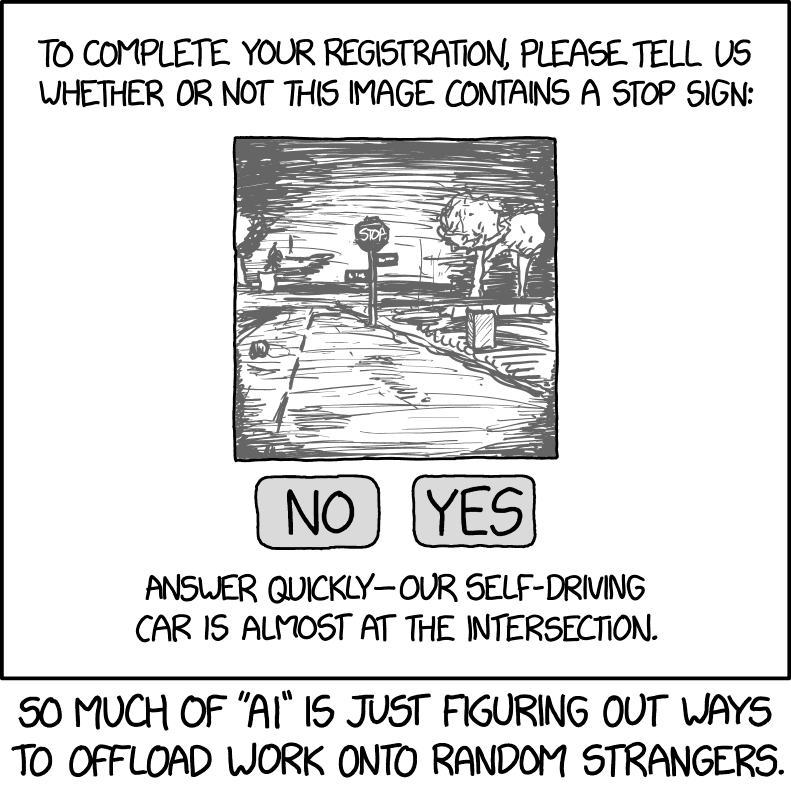Relevant XKCD:

Why not post a link to the actual XKCD comic and give the author the views instead of a random site?
The random site is their lemmy instance’s pictrs. Randall doesn’t care about reposting, and this is nicer since you don’t have to leave lemmy
In fact he doesn’t care about reposting so much that he Creative Commons licensed his whole comic.
Yeah but the alt-text. Now I have to look up the comic page for it.
Search explainxkcd for the words in the image
So much for “nicer since you don’t have to leave lemmy”
The alt texts are one of the best parts of xkcd
It turns out a lot of people (who aren’t otherwise interested in xkcd but would like a relevant one in the moment) really don’t care about the alt-text and titles.
I’m with you, but more often than not in the “relevant xkcd” moment, people lack interest for the alt text.
Today I learned :)
Aw man I’ve been making this joke thinking I’m clever for years but I read xkcd pretty frequently. I must have inadvertently stolen the joke from Randall.
There’s probably an XKCD about that.
Well there’s https://xkcd.com/16/. Or https://xkcd.com/33/.
Haha good stuff ty.
At first I was thinking, a bit of human supervision could not be too bad. And then I got to the part where they said 1.5 workers per vehicle. My maths may be off, but to me that sounds like 0.5 more than is necessary to drive a normal vehicle.
Theranos? Maybe, but at that point, I’d compare it to https://en.wikipedia.org/wiki/Mechanical_Turk too.
When I worked at Waymo, we had a ratio of about 10 cars to 1 remote human. I dunno if Cruise is being over-protective, if their tech is just that bad that they need more people than cars, or if the number is just incorrect.
Either way, it hardly matters. It’s not like these things are commercially available for a long time yet, anyway. In the testing stages - which Cruise 100% is still in - you definitely want a sturdy team of humans capable of intervening for safety reasons.
If the cars are running all day long it might make sense to need another human to pick up later shifts. Still though, that ratio is way too high to be economical.
Chonky TL;DR because I was a little annoyed that there wasn’t one here -
Certainly no commercial product could ever work at a profit if you needed remote operators anything like that often. As Brooks points out, the term “autonomous” barely applies.
Beyond what Brooks pointed out, the story also notes “Those vehicles were supported by a vast operations staff, with 1.5 workers per vehicle”.
Fitting with this general vibe, a source (that in fairness, I don’t know well) just told me that his impression having visited with them not so long ago was that “they’re definitely relying on remote interventions to create an illusion of stronger AI than they really have”.
if Cruise’s vehicles really need an intervention every few miles, and 1.5 external operators for every vehicle, they don’t seem to even be remotely close to what they have been alleging to the public. Shareholders will certainly sue, and if it’s bad as it looks, I doubt that GM will continue the project, which was recently suspended.
As safety expert Missy Cummings said to me this morning, remote operators could well be “the dark secret of ALL self-driving.”
Human lives at are stake.
Cruise CEO Kyle Vogt essentially confirmed that their “driverless” cars need very regular human intervention:

🤣😂
But the average Whitedude Techbro AI company CEO is looking very seriously into the camera and telling me AI is coming for my job next year…
1.5 operators per vehicle!?
Consider that"dumb" cars are only 1 operator per vehicle. This is somehow reverse-AI
- NYT writes article
- Roboticist tweets about one fact in it
- Substack blogger turns that tweet into a sensational headline
You can just watch the different food chains interacting here from legit media to independent authority to bottom feeding headline-shagger.
4: Insightful comments on Reddit / lemmy tearing apart the sensationalism, but getting buried under lame jokes.
Unfortunately, the substack article seems to be freely accessible, while the NYT isn’t. I understand the whole supporting journalists angle, but having to sign up to read stuff so they can more easily correlate what I click on and sell usage pattern data rubs me the wrong way.
I’m a paying NYT subscriber so I guess “supporting journalists” (why did you even put this in quotes?) is more important to me than “vague fears” of “personalized advertising” which are probably much the same on every “website” in “the world.”
why did you even put this in quotes?
IDK, it’s early morning and I felt like it was an established term. I’m sure I was thinking something, but I can’t reconstruct just what. I’ll fix that.
I have a personal distaste for login-walls. I’m fine with disabling my adblocker for sites I trust and enjoy, but I just don’t like walled-off content. I’m doing my best to avoid tracking cookies, including manually going through the cookie settings on those notifications and clearing cookies on sites I don’t need to stay logged in on. Courtesy of GDPR and judging by the variety of irrelevant ads I do get, I like to think I’m doing a mostly solid job.
Nobody has a personal taste for parting with their money. The question is whether you care about the quality of media that’s available or are content to live on sensationalist headlines forever. Here’s your cue to cherry-pick some complaints about times the NYT did something wrong. I’ll add that to the list of excuses for why you won’t support journalists alongside your “privacy concerns” and personal distaste for paywalls. I think it’s funny when people believe that the lane excuses they tell themselves make for a convincing argument to others.
Headline shagger has me in stitches
Autonomous cars would complete the hellish dependency on cars in many cities.
As a partially sighted person that’s unable to legally drive, an autonomous car is an absolute dream to me and would give me a personal freedom many currently take for granted.
In our car dependent society, I understand that. But a lot of us would rather have better public transit so you wouldn’t have to have a car to have your freedom.
I definitely understand that perspective and I would never say no to better public transport. However, as someone that has spent their entire life entirely reliant on public transport, I can assure you that even good public transport isn’t a solution to all problems.
For example I can’t just nip out to a hardware store to pick up some supplies because I fancy doing a bit of DIY, I am reliant on friends or Taxis to carry bulky items. I can’t even do a large shop because it’s too much to carry, I have to either have it delivered in which case I’m not able to easily see what I am getting - an issue be it fresh produce or just not realising how big a jar of something is, or I am forced to turn one shopping trip into several smaller trips. I certainly can’t buy in bulk to save money.
I can’t just go somewhere on a whim, I have to plan ahead and make sure I’m able to get any connections or be aware of any disruption.even when public transport is good, it still has issues.
You make great points that sighted people like myself might not ever consider.
IMO there should exist public options to take care of these gaps that you have. Right now I don’t think there are really any groups of people who have both the means and the motivation to solve any of these issues. It sucks. I believe these issues are solvable.
Isn’t delivery an option in this case?
Believe me it’s often the only option I have and it has a whole host of problems. Things sometimes aren’t in stock and you get dumb substitutions or no substitution at all - which means I still need to go and pick up whatever I’m missing or make do without.
For fresh produce, it’s entirely random if I get decent selection or bruised up leftovers. If I want baked potatoes I have no way of picking them myself and end up with crappy tiny things unless I buy the more expensive explicit “jacket potatoes”.
It’s a nightmare.
I’m hoping they are sorted by the time I’m 80 and can no longer safely drive myself.
They offer the chance to push the average number of occupants per vehicle below one.
They also offer the chance to push it above one. Ride-sharing will be a lot more attractive with autonomous cars.
Why?
I see the more realistic probability of the car picking up and then dropping off a passenger, and then picking up another. I don’t think customers would be happy if the car they were riding made their trip longer in order to force them to share the car.
You just need price incentive, make it cheaper if it is shared, it’s economically sound.
There will be taxis that work pretty much like they do today. But there will also be mini buses that carry secret passengers and are cheaper. It’s not an either/or situation.
It could reduce the need for individual cars by increasing car sharing.
That’s Car Sharing, not autonomous vehicles, no? Car Sharing is a good thing, definitely, but we really need to get rid of cars. Not completely, but to a point where it’s not the default.
With autonomous cars, you don’t need a driver to bring it to the next person who needs it. That’s a big limitation of current car sharing, it prevents a lot of possible sharing from happening as cars spend 95% of their lifetime parked. Indeed, we need less and smaller cars, and I think autonomous car would help with that by increasing sharing and usage time.
But how would I flex my wealth to the peasants then? /s
Easy, buy a $15,000 dollar bike.
But you can do car sharing with any kind of car. In Germany there are cities that run a rent service for their citizens who only need a car occasionally.
Obviously this only works in the context of a robust public transport infrastructure and in cities built for humans rather than cars, so that the need for a car becomes a rare occurrence.
American cities don’t generally fit that description and until they do the type of car they use won’t change a thing, because it’s not addressing the core problem.
Same answer as the other similar comment: https://jlai.lu/comment/3237143
No they wouldn’t. Once most cars are robotaxis, there will be drastically less space needed for car parks which will free up huge amounts of space. That can be used for bike lanes, so cycling becomes safer and more convenient. And I don’t expect most rides to be single occupancy. People will opt for shared rides if they are substantially cheaper, which would cut the number of vehicles on the road. Autonomous cars are actually the best chance we have right now to escape the car centric hellscapes of our current cities.
And I don’t expect most rides to be single occupancy. People will opt for shared rides if they are substantially cheaper,
Bus. That’s called a bus. It can also fit more than five people and doesn’t use as much energy to transport each person. You just reinvented a shittier bus
Wrong. I invented a better bus. Well, i didn’t, none of this is new. A bus that goes straight to your destination with few or no stops. A bus that always tells you exactly when it’s going to arrive. A bus that can go to a lot of places a large bus can’t. And of course one that’s a lot quiet and cleaner. What exactly is your problem with that concept?
Traffic jams and cost. You can’t be this stupid, can you? I literally pointed out buses take up less space and use less energy. Why ask your question as if I hadn’t pointed out the negatives of your solution compared to buses (or other public transit vehicles).
Also, it’s not quiter or cleaner, since more cars = more noise compared to one bus (you can’t consider the vehicle without considering it’s capacity), and you generate a lot more pollution (rubber tires produce a lot of particles, and you have more vehicles and more tires with taxis). So stop lying.
The reason people in cities with proper transportation don’t worry that much about getting a bus directly to their destination is that the network is comprehensive enough to cover all manner of trips, from any one point in the city to another. Same with frequency, if it’s arriving in less than 5-10 minutes it doesn’t matter when exactly it arrives.
Have you ever gotten on a bus? My car is in the shop and I’ve been riding the bus to and from work for about a month now. The bus smells of pee, a fair few of the denizens who ride with me smell of pee, and last week a guy got pepper sprayed or maced by the police for being high (near as I could tell) at the bus stop. I’ve ridden transit all my life (quite literally grew up riding public transit to school and so on), and I gotta tell ya, I’ll ride share before I’ll actively ride a bus. Especially considering the ride share would get me to work in half an hour and the bus takes about an hour and 45 minutes.
Those are reasons to fund better public transit, not double down on smaller cars.
Better public transit than Seattle, NYC, Philly, Chicago, and San Francisco? Seriously. Seriously. I’ve lived all of these places and I gotta tell you, it’s bad everywhere in the US and the problem isn’t the transit. It’s people.
Literally any city in Europe or china has better public transit than anywhere in the US, and it’s not even close.
So your suggestion is to attack transit in America in a way that would not work for American because of America’s unique problems with scale. Good to know. Do you know what would happen in most major cities in the US if all the car drivers suddenly had to take public transit? It would overwhelm any system you put in place. And the pollution would be astronomical.
I’m all for walkable cities and suburbs, and I’m even good with reducing the number of people who need to drive and therefore cars on the road. But this isn’t a zero sum game. So unless you can show me a plan that is viable to take the place of the system I don’t really want to hear naysaying about electric robotaxis or any of that.
This has been studied.
I firmly believe the solution is autonomous shuttles, not cars. Imagine having bus routes that can dynamically change and adapt to demand. Say we replace every bus with 2 smaller shuttles: during normal service the route could have the same capacity, but if there is an extraordinary event (sports event for example) you could divert them from the low-demand areas to the extraordinary-demand zone.
During lower demand times, you can also have more routes at no extra cost. If you’re clever and make an app to call the shuttle (think Uber but through pre-established routes) the demand can be determined in real time to ensure you don’t have empty shuttles.
And because they’re bigger than passenger cars you’re still increasing the ratio of passengers per vehicle, unlike robotaxis which merely replace private cars, with mostly 1- or 2-passenger trips.
Just like regular taxi, they reduce the need for parking spots. Personal car taking valuable real estate all day long are a big problem.
Just asking questions title
Pleeeeeeeaaaaase be true please please please be true .
Yeah the dark “secret” is they have spent $100 billion dollars and these cars still can’t do anything useful and relatively safe.
Which is why it’s a lot like Theranos; they raised (and burned through) a ton of money trying to build something that would be really useful but was still decades from technological feasibility.
not decades from feasibility. But a physical impossibility. Some of the stuff they were supposed to detect was literally not present in a detectable quantity in the single drop of blood they scanned.
Well I should hope autonomous driving tech people believe they can make it work, despite the incredible expense and waste.
Sar please stay on the road


















